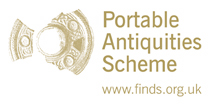File:Bronze Age Carp's tongue sword (fragment) (FindID 551092).jpg

Original file (2,788 × 1,588 pixels, file size: 751 KB, MIME type: image/jpeg)
Captions
Captions
Summary
[edit]| Bronze Age Carp's tongue sword (fragment) | |||
|---|---|---|---|
| Photographer |
St. Albans District Council, Julian Watters, 2013-03-21 13:52:59 |
||
| Title |
Bronze Age Carp's tongue sword (fragment) |
||
| Description |
English: A copper-alloy fragment from a Late Bronze Age sword.
The fragment represents a sub-rectangular piece of the blade, with a straight, horizontal break or cut at both the top and bottom ends. There is a broad, convex-surfaced mid-rib on either face, flanked by a pair of vertical grooves. Either side of this mid-rib the thickness gradually tapers towards the cutting edge. The breaks are well patinated and indicate that it was broken in antiquity. Dimensions: 37.1mm long, 33.2mm wide, 8mm thick (maximum, at mid-rib). Weight: 39.42g. Katie Hinds (pers. comm.) identifies this piece as a fragment from a 'Carp's tongue' type sword. Peter Reavill (pers. comm.) also suggests it is probably of this type but states that the small size of the piece precludes a definite attribution. According to Reavill, Carp's tongue swords, allied to the Ewart Park phase of metalwork, date from between c. 1000 and c. 800 BC, which fits in with Needham's Period 7 (Metalworking stage XII). Such small pieces are typical finds - it is rare to find a complete example of the sword - and tend to be found either in hoards or in close proximity to waterways or the coast*. Their distribution is concentrated on northwestern France and in central and southern Britain. Comparable pieces recorded on the PAS database include BH-4C7707, from Ayot St. Lawrence, Hertfordshire and ESS-3BF240, from Burnham-on-Crouch, Essex. |
||
| Depicted place | (County of findspot) Hertfordshire | ||
| Date | between 1000 BC and 800 BC | ||
| Accession number |
FindID: 551092 Old ref: BH-9CC7C7 Filename: BA_sword_13_6_1.jpg |
||
| Credit line |
|
||
| Source |
https://finds.org.uk/database/ajax/download/id/420766 Catalog: https://finds.org.uk/database/images/image/id/420766/recordtype/artefacts archive copy at the Wayback Machine Artefact: https://finds.org.uk/database/artefacts/record/id/551092 |
||
| Permission (Reusing this file) |
Attribution-ShareAlike License version 4.0 (verified 28 November 2020) | ||
Licensing
[edit]- You are free:
- to share – to copy, distribute and transmit the work
- to remix – to adapt the work
- Under the following conditions:
- attribution – You must give appropriate credit, provide a link to the license, and indicate if changes were made. You may do so in any reasonable manner, but not in any way that suggests the licensor endorses you or your use.
- share alike – If you remix, transform, or build upon the material, you must distribute your contributions under the same or compatible license as the original.
File history
Click on a date/time to view the file as it appeared at that time.
| Date/Time | Thumbnail | Dimensions | User | Comment | |
|---|---|---|---|---|---|
| current | 12:19, 30 January 2017 |  | 2,788 × 1,588 (751 KB) | Fæ (talk | contribs) | Portable Antiquities Scheme, BH, FindID: 551092, bronze age, page 3896, batch count 8512 |
You cannot overwrite this file.
File usage on Commons
The following page uses this file:
Metadata
This file contains additional information such as Exif metadata which may have been added by the digital camera, scanner, or software program used to create or digitize it. If the file has been modified from its original state, some details such as the timestamp may not fully reflect those of the original file. The timestamp is only as accurate as the clock in the camera, and it may be completely wrong.
| Orientation | Normal |
|---|---|
| Horizontal resolution | 275 dpc |
| Vertical resolution | 275 dpc |
| Software used | Adobe Photoshop Elements 2.0 |
| File change date and time | 09:40, 27 February 2013 |
| Color space | Uncalibrated |
| IIM version | 2 |
